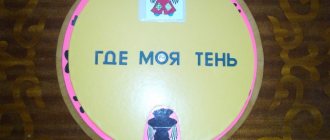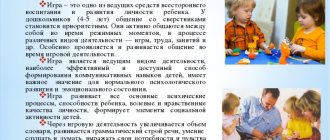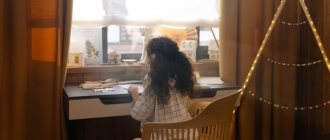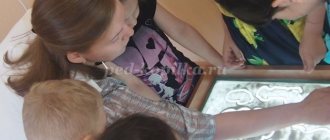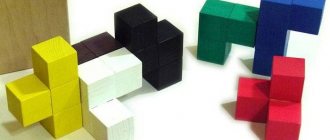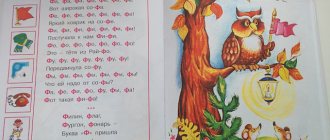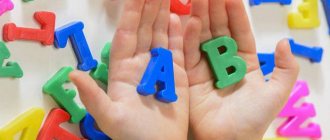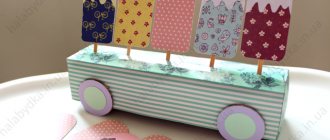“We develop by playing.” Educational and methodological manual for educators and parents of children.
Elena Valentinovna Voronina
“We develop by playing.” Educational and methodological manual for educators and parents of children.
“We develop by playing”
In order for our children to have a happy childhood, play should occupy the main place in their lives. In childhood, a child has a need to play. And it must be satisfied not because work takes time, fun takes an hour, but because while playing, the child learns and experiences life.
This album presents manuals from non-standard materials for children's play activities aimed at their mastering sensory standards. The use of modern materials in teacher practice that meet aesthetic, hygienic and pedagogical requirements is very justified.
Didactic manual “Flower Glade”
To develop children's imagination and the formation of visual-motor coordination based on actions with objects, a didactic manual “Flower Glade” was produced. It attracts attention with its brightness and interesting content.
Description of the manual: The manual consists of a board with glued flowers made of self-adhesive film; in the center of the flower there is a hole cut into which the necks of bottles of different sizes are glued. There are plugs screwed onto the necks.
Examples of didactic games and tasks using the “Flower Glade” manual.
Goal: consolidation of knowledge of size; colors; development of hand motor skills.
“Pick the middle to the flower”
“Wrap the largest center of the flower. The smallest one"
“Wrap the red center of the flower. White"
Didactic manual “Finger dry pool”
Dry pool - used for simultaneous active stimulation on various points of the hands, fingers, palms; sensorimotor development, the formation of basic sensory standards: shape, size, material, weight, sound; fostering perseverance and patience in work; relieving emotional stress. It’s very simple to make: fill the Kinder Surprise capsules with various fillings (rice, peas, beans, cover them with thermal film for Easter eggs, put them in a small deep plastic container, hide the Kinder Surprise toys at the bottom.
Ask your baby to look for various small objects or toys in the dry pool. By plunging as deeply as possible into the filler, the child’s hands are massaged, the fingers become more sensitive, and their movements become coordinated.
This manual can be used in music classes.
Didactic game “Beads from salt dough”
Goal: strengthening and development of fine motor skills, visual-motor coordination; developing the ability to combine colors; development of concentration; development of perseverance, accuracy, children's creativity, a sense of beauty in one's own work and the work of other children; learning how to work from a sample and create your own product.
This benefit can be done by the child himself, with a little help from an adult. Dough modeling really helps develop a child's motor skills. After all, a baby can change the shape of an object from a spherical shape to a square or triangular one. And, taking a piece of dough in his hands, he can feel its weight, heaviness and viscosity.
Description of the preparation of the manual:
Prepare salt dough (mix 1 glass of “Extra” salt, 1 glass of flour, 0.5 cups of cold water, leave for 2-3 hours in the refrigerator, form balls, make holes in them using a cocktail straw, leave until completely dry. Beads ready!
Didactic manual “Place the eggs in your houses”
Goal: to develop the ability to distinguish and correctly name the 4 primary colors;
learn to combine a testicle with a cell, perform correlating actions (color guide); act purposefully, sequentially: from left to right, without skipping cells; develop fine motor skills of the fingers.
Description of the tutorial: Paint the cells of the egg container with the main colors and varnish them. We tie the Kinder Surprise capsules in the appropriate color.
The result is a bright and beautiful manual.
Children must arrange the eggs into houses according to their color.
If possible, name the color of the eggs and the color of the houses.
Didactic manual “Place the pencils in cups.”
Goal: to develop the ability to distinguish colors; learn to combine a pencil with a glass; act purposefully, sequentially: from left to right; develop fine motor skills of the fingers.
Description of the tutorial: Cut out rectangles and pencil shapes from ceiling tiles. We cover the rectangles to the middle with squares of self-adhesive film of different colors. We paste the pencils with the corresponding colors. Fast, beautiful, economical!
Didactic manual “Ladybug find your clearing”
Goal: distinguish colors and understand color names, learn to select objects of the same color.
Description of the preparation of the manual:
We make ladybugs from disks, covering them with self-adhesive film. We cut out flowers from linoleum and paste them with the corresponding colors. Leave part of the disc unpasted so that when a ray of sunlight hits it, it will glare. The manual attracts attention with its brightness and interesting content, and children enjoy working with it.
"Sensory trail for feet"
This is a maple track on which materials of different textures are sewn. The variety of sensations makes walking along the path exciting. Such walking is useful for the development of tactile perception, as well as for coordination of movements and the prevention of flat feet. For a more complete experience, it is recommended to walk barefoot or wear thin socks.
Didactic manual “Mosaic”
Assembling a jigsaw puzzle is very important for a child’s mental development.
Playing with mosaics involves fine motor skills of the hands, develops imaginative thinking and imagination, and develops the ability to distinguish and correctly name colors. Moreover, mosaic develops the child’s artistic taste, the ability of children to navigate the plane of the playing field, and allows them to show creative activity.
Description of the preparation of the manual:
Option No. 1: Print large pictures of coloring pages, cut out along the outline, place the template on a mosaic board (secure with tape for convenience).
Option No. 2: Print large color pictures of coloring books, glue them on wooden planks, drill holes along the diameter of the mosaic.
It is difficult for young children to create mosaic images on their own, but they do an excellent job of working from a template.
Didactic manual “Magic clothespins”
In order to firmly, easily and firmly hold a pencil (ballpoint pen) in the hand, the child must have developed 3 fingers of the right (left) hand. The clothespin promotes the formation and then the development of the movement of squeezing and unclenching the fingertips of the right and left hands. To make the game interesting for a child, you can attach clothespins according to the theme (rays to the sun, needles to a hedgehog, petals to a flower, ears to a bunny’s head)
Description of the preparation of the manual:
Print out large color plot pictures, cut them out without any elements, and glue them onto the linoleum. On the back side, paste the text with the task in poetic form.
When children learn to put on and take off clothespins, you can offer them games and tasks.
“Make branches for the tree”
Using clothespins of the same color
Goal: to teach children to select the right clothespins of the same color, to develop fine motor skills and tactile sensations.
“Make thorns for the hedgehog”
Alternating clothespins by color
Goal: learn to alternate clothespins of two colors; develop fine motor skills of the hands.
"Make some rays for the sun"
Expression of creativity
Goal: to learn to use the color scheme of clothespins of your choice, to develop creativity and fine motor skills.
Didactic manual “Autumn Leaves” and “Mushroom Picking”
Goal: distinguish colors and understand color names, learn to select objects of the same color, but different sizes. Establish identities and differences in color of homogeneous objects. Learn to understand the words “such”, “not such”, “different”.
Description of the preparation of the manual:
We cut out leaves, mushrooms, and baskets from linoleum and paste them with the appropriate colors. Leaves of different shapes and sizes. This manual can be used in music and physical education classes.
Didactic manual “Dress the doll”
Goal: To consolidate the ability of visual and tactile examination of objects and materials and the ability to analyze their properties and qualities;
Exercise and activate visual functions and fine motor skills;
Teach children to name an object and its color; speech development and exercise in the use of different grammatical forms;
Cultivate a caring attitude towards things, provide mutual assistance to each other when dressing.
Description of the preparation of the manual:
Knit clothing pieces of the same color.
Our boys and girls take great pleasure in dressing up dolls.
Didactic manual “Lay out on plates”
Goal: To teach children to distinguish colors and use the names of colors in speech. Strengthen the ability to recognize geometric shapes and name them (circle, square, triangle). Learn to understand the words “such”, “not such”, “different”. Develop fine motor skills of the hands.
Description of the preparation of the manual:
Disposable plates in 4 main colors. We cut out geometric shapes from linoleum and paste them with the appropriate colors.
Didactic manual “Roll the ball through the gate”
Goal: To teach children to match objects by color; introduce the concept of “round”; form an idea of the size of objects; consolidate the ability to perform practical and playful actions with objects in accordance with their properties (shape).
Description of the preparation of the manual:
Wooden collars and balls in 4 main colors.
Didactic manual “Reels”
Goal: to introduce children to threads; tell about their purpose; teach how to wind thread on a template; develop fine motor skills and the ability to perform actions with both hands at the same time.
Description of the preparation of the manual:
Cut out a spool template from plexiglass, wind threads of different colors.
Didactic manual “Bus”
Objectives: to learn to distinguish between round and square objects;
navigate on a plane; learn to combine shapes with an object, perform correlative actions (color guide); develop fine motor skills of the fingers;
teach understanding of words and phrases: “bus”, “the bus has wheels, windows”; replenish the child’s vocabulary with the words: “car”, “driving”, “standing”.
Description of the preparation of the manual:
We cut out bus stencils from plastic, without windows and wheels. We make the wheels and windows in the appropriate shape (circle, square). We cover the manuals with self-adhesive film in the appropriate colors.
Program "Baby"
Author V. A. Petrova.
Goal: development of musical abilities of children of the third year of life in all types of musical activities available to them, familiarization at an early stage of preschool childhood with the world of musical culture and high spiritual values.
This is a new program for musical education of young children (3rd year of life). It was developed by the author based on many years of experience in practical work with children.
The “Baby” program is designed for the real possibilities of musical development of young children and the variability of the tasks of the musical repertoire depending on the characteristics of a particular group.
The program includes work with teachers and parents. The package of materials includes:
1. Program.
2. Reader of the musical repertoire.
3. Methodological recommendations for all types of musical education, as well as for holiday matinees and leisure activities.
4. Audio cassette recording of instrumental music for listening to performance by symphony and string orchestras.
.
Start technology
Author L.V. Yakovleva.
In developing the program, the author was assisted by a member of the Federal Expert Council on General Education of the Ministry of Education of the Russian Federation R. A. Yudina and an orthopedic doctor, head of the children's clinic of the Central Research Institute of Traumatology and Orthopedics, Doctor of Medical Sciences L.K. Mikhailova.
The content of the program reflects many years of practical experience in teaching healthy lifestyles with preschool children (from toddlers onwards).
The author refused to distribute the material by age groups, justifying this by the fact that such an approach artificially inhibits the development of the child. The technology contains material on the use of acrobatic exercises, exercises on non-standard equipment for preschoolers, and stretching exercises.
The program consistently addresses the following questions:
- how to use standard and non-standard equipment when working with preschoolers;
- methods for diagnosing motor activity of children to determine their sports interests and abilities;
- recommendations for developing a work system, taking into account the conditions of a preschool institution;
- features of interaction between the physical education teacher and the group teacher;
- notes of physical education classes outdoors and in the hall;
- approximate complexes of health-improving gymnastics, exercises for breathing development.
Program “Introducing children to the origins of Russian folk culture”
Authors: O. L. Knyazeva, M. D. Makhaneva.
Goal: to form the basis of culture in preschool children (3-7 years old) based on familiarization with the way of life and the life of their native people, their character, their inherent moral values, traditions, and cultural characteristics.
The educational goal of the program is to introduce children to all types of national art - from architecture to painting, from dance, fairy tales and music to theater.
The program consists of three parts. The first contains specific recommendations for the implementation of the program and organization of the developmental environment in preschool educational institutions, and highlights the forms and methods of interaction between the teacher and children. The second part provides long-term and calendar plans for working with children of all age groups, and describes in detail the content of all classes. IN
The third part includes applications: literary, historical, ethnographic, historical texts, a dictionary of Old Church Slavonic words most often used in fairy tales, proverbs, and sayings.
The program is recommended by the Ministry of Education of the Russian Federation.
Program “Development of children's ideas about history and culture”
.
Authors: L. N. Galiguzova, S. Yu. Meshcheryakova.
Goal: to develop in children of senior preschool age the foundations of spiritual culture, a humane attitude towards people and their work, respect for the cultural values of different nations; development of cognitive activity and creative abilities. The program consists of four sections:
- primitive people;
- wonders of the ancient world;
- travel with a fairy tale;
- before and now.
The content of classes for each of the listed sections is set out in a separately published manual, which contains illustrations, games and simple tasks.
The program, at an accessible level, introduces children to the lives of people in different historical eras and gives basic ideas about technological progress.
Program "Musical Masterpieces"
Author O. P. Radynova.
Goal: formation of the foundations of musical culture in preschool children, development of creative abilities in various types of musical activities.
The author offers a clear system of work based on the use of works of art, authentic examples of world musical classics.
The center of the program is the development of children’s creative listening to music, which involves encouraging children to demonstrate various forms of creative activity - musical, musical-motor, artistic.
The basic principle of constructing the program is thematic (the presence of 6 topics that are studied for one to two months and repeated on new material in each age group.
The program has developed methodological recommendations for teachers, a system of classes for all age groups in kindergarten, conversations, concerts, and entertainment.
The program provides an interconnection between cognitive, value-oriented and creative activities of children in the process of forming the foundations of musical culture.
The program is recommended by the Ministry of General and Professional Education of the Russian Federation
Programs for the social and moral development of preschool children
Program "I, You, We"
Authors: O. M. Knyazeva, R. B. Sterkina.
Goal: social and emotional development of a preschool child, the formation of his emotional sphere and social competence.
The program helps to solve a complex of problems related to the education of moral standards of behavior, the ability to build relationships with children and adults, to adequately resolve conflict situations, and to adequately assess one’s own capabilities.
The program includes the following sections:
- "Self confidence";
- “Feelings, desires, views”;
- "Social skills".
The content of the program is implemented on the basis of non-traditional variable lesson scenarios using a set of educational and visual aids for children’s independent activities.
Methodological recommendations are given to teachers and parents. The set includes educational and visual aids: “What are you like?”, “What do you like?”, “Happy, sad...”, “We are all different”, “How to behave?”, “Who are you friends with?”
Recommended by the Ministry of Education of the Russian Federation
